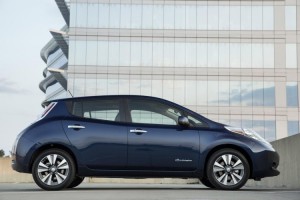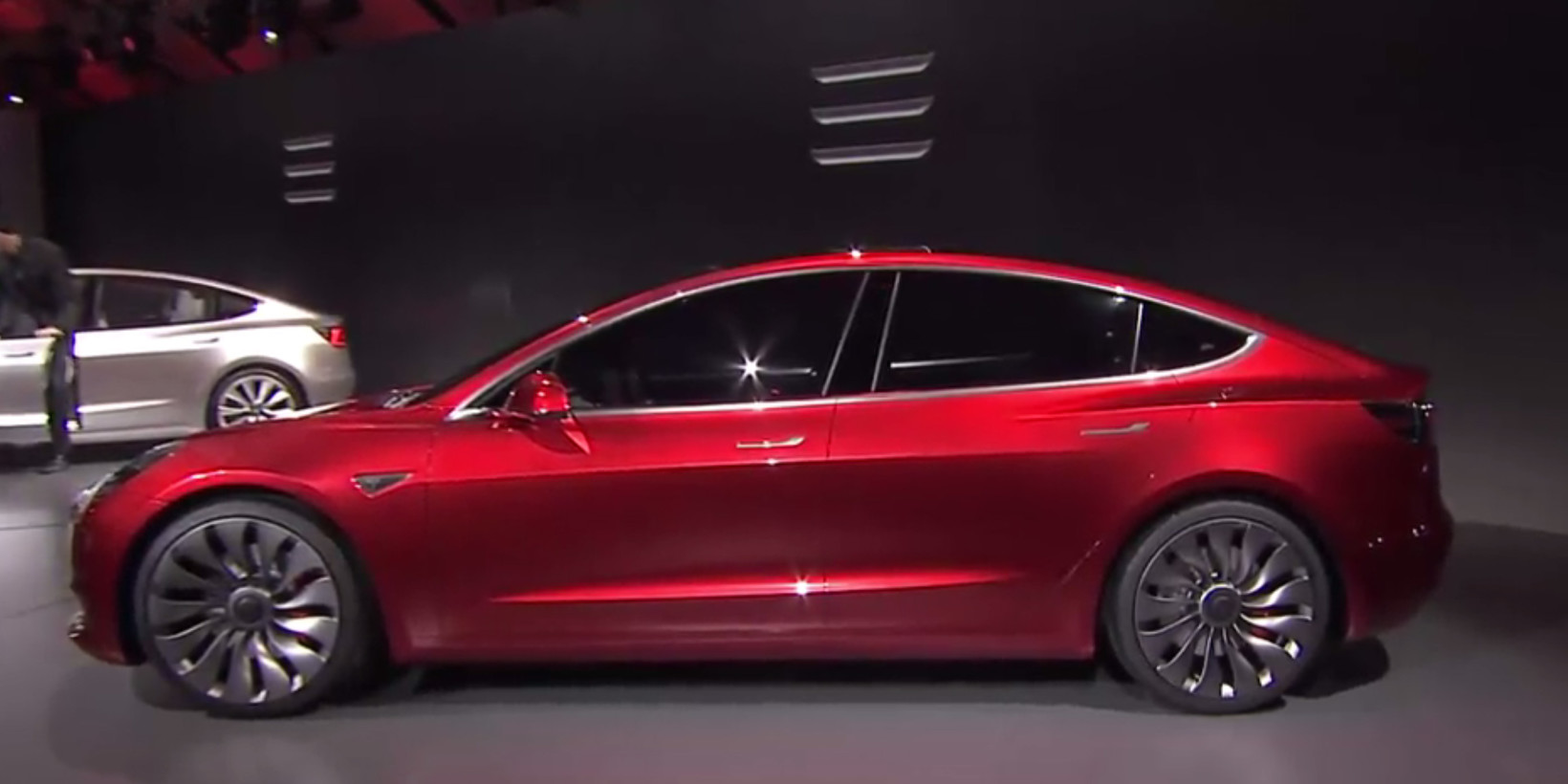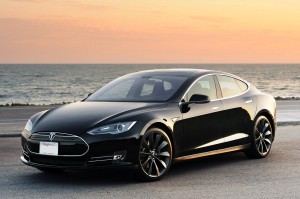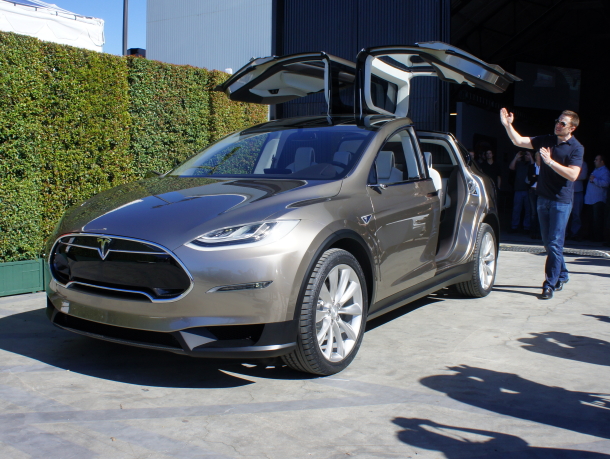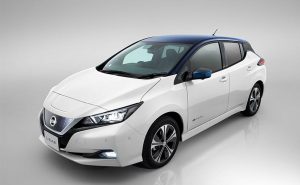 Last week, Nissan became the third major automaker to unveil its second generation electric vehicle, after Tesla’s Model 3 and Chevy’s Bolt. The new all-electric LEAF is certainly an improvement over the original, which was groundbreaking in its day for being the first mass-market, affordable short-range electric vehicle. But it’s ultimately underwhelming.
Last week, Nissan became the third major automaker to unveil its second generation electric vehicle, after Tesla’s Model 3 and Chevy’s Bolt. The new all-electric LEAF is certainly an improvement over the original, which was groundbreaking in its day for being the first mass-market, affordable short-range electric vehicle. But it’s ultimately underwhelming.
Here is the good news:
- The design is much better. The old LEAF looked like a bug (and not in a good way like Volkswagen). This version is much sleeker and more appealing to the eye, bringing some needed style (photo above).
- The battery range is much improved. The old range was 85 miles, which went to 105 miles in the last version. This second generation vehicle can now go up to 150 miles, with plans for a 200-range model perhaps next year or 2019.
- The driving features are better. In particular, Nissan is catching up to Chevy with the “one-pedal drive,” where the car starts braking immediately upon release of the accelerator. It also has some “lane assist” and automatic braking features, also like the Bolt but well behind Tesla’s self-driving features.
- It’s super cheap, compared to other EVs. Despite the increased range, the price has actually fallen a bit, to below $30,000 (before incentives). That means that even though it has 80 miles less range than the Bolt, it’s also starting at $7000 cheaper. I gather that’s the big hope at Nissan, that the car will sell well because it’s cheaper.
But the bad news:
The range is pretty underwhelming, given what the Bolt just pulled off (238 mile average range per charge). How much money is that extra 45 miles over the last LEAF worth to the potential consumer, when they can get a cheaper, older LEAF with about 85 or 90 miles of range for about one-third of the cost of this car?
So ultimately, besides cost savings, what is this car offering a potential EV consumer? It’s hard to see, given the sporty Tesla Model 3 soon to hit the market, and the quality, affordable, long-range Bolt already available.
I certainly wish Nissan well and hope the car sells. But it feels like the company has some major catch-up to do to stay relevant in the EV world.
While Tesla and General Motors have already made public strides towards the seemingly magic 200-mile range electric vehicle for under $40,000, Nissan has been quiet. The bug-like LEAF, the leading electric vehicle on the road, has been out for five years, yet has had no redesign and little improvement, other than the option to buy a slightly bigger battery pack to get 105-mile range.
Per Green Car Reports, now a Nissan engineer has finally come forward to confirm that the next generation LEAF will have a 60 kwh battery pack — enough to achieve a 200-mile plus range. Of course there’s no timetable for when it will be released, but one would hope that it will happen by 2018.
While the delay is frustrating, in a few years there will be at least three EVs that can go 200 miles for less than $40,000: the Tesla Model 3, Chevy Bolt, and new Nissan. By 2030, we could see a dramatically different market for these vehicles, with significant effects on gas consumption, as Forbes reports on a new Wood Mackenzie study:
The U.S. currently uses more than nine million barrels of gasoline a day. According to the report, if electric cars gain more than 35% market shares by 2035, the U.S. could see a cut from nine million to two million barrels used a day.
This outcome is hardly out of the question, and it underscores how critical electric vehicles are to our environmental future. If Nissan can get its 200-mile act together, it will be a major part of the solution.
Elon Musk did his big reveal last night on the long-awaited Tesla Model 3, the most anticipated mass-market electric vehicle. The vehicle promises some pretty amazing things, mainly a minimum 215-mile range at a base price of $35,000. Meanwhile, it will have autopilot features now found on the company’s electric SUV Model X.
How can they do all this for that price? The answer is the “gigafactory” for batteries outside Reno, currently under construction. As Musk describes in the video above, it’s the largest footprint building in the world that will produce more lithium ion batteries than all other facilities in the world combined. Now that’s a textbook example of economies of scale.
And in terms of look, it’s hard to deny that this is one sporty-looking performance vehicle, with an all-glass roof (hello squeegees!) and sleek, Porsche-like lines:
Meanwhile, as of last night, over 115,000 people have already deposited $1,000 to pre-order one.
It’s hard to deny that this is a historic moment in the history of electric vehicles, and by extension sustainable transportation. While the Chevy Bolt promises similar range and price, Tesla has the cache and history of innovation to deliver a market winner for the masses.
But the car won’t be available for probably another two years. So what does that mean for the industry in the interim?
The effect could actually be counter-productive for the electric vehicle industry. With such an appealing car waiting in the wings, why would someone want to buy one of the existing models out there now, when they’re priced about the same but have less than half the range of the Model 3 and none of the cool features or glitz?
Just as an example, think of the “new” Nissan LEAF. After five years in production, the new version from Nissan basically looks the same as the original and only has 20 additional miles of range, to 105 miles. And it costs about $32,000 before incentives. So why would I buy that LEAF now when in two years, for the same price, I can get more than twice the range and all the excitement and features of a Tesla?
For buyers like me who want to stay electric, we’ll probably just continue leasing, in order to wait out the next two years until the Model 3 and possibly other models like it are on the market. While this dynamic has always been present to some extent (the belief that the technology is improving so rapidly it’s not worth investing in a new EV just yet), the Model 3 unveil could put that psychology on steroids.
If I were working at Nissan, Chevy or BMW right now, I’d sure be worried about this trend. And I’d also be on notice that the whole industry needs to up its game in response to the Model 3.
Electric vehicles have had a down year, and many people blame low gas prices, per the Associated Press:
At their peak in 2013, with gas averaging $3.50 per gallon, Americans bought only 341,000 hybrids and electrics, about 2.2 percent of total U.S. car sales, according to Kelley Blue Book.
Companies spent millions developing the cars, taking losses to meet government fuel economy standards that gradually increase and require the new-car fleet to average 54.5 miles per gallon by 2025.
As gas prices fell below $2 per gallon, sales of hybrids and electrics dropped further. Last year, automakers had 16 hybrid and electric models on sale, but sales sank to just over 274,000.
But poor marketing is a big part of the story, too. Many automakers tried to sell the vehicles as an eco-friendly alternative or competitor to the popular hybrid vehicles like the Toyota Prius. That might explain why the Nissan LEAF is called a “leaf” and looks vaguely like a goofy Prius.
But in their haste to please the eco crowd, these automakers were overlooking one critical attribute of an electric vehicle: they are fun to drive.
Tesla realized this early on, and as a result have successfully positioned their vehicles not just as an eco-toy for the rich but as a new and exciting technology that drives better than clunky old gas cars. In fact, most Tesla buyers don’t actually care about the environment but instead are interested in access to new technology.
But now with gas prices so low, other automakers are coming around to marketing the performance aspect, from the same article:
At the New York International Auto Show on Wednesday, Hyundai and Toyota showed off new electric and hybrid vehicles, with presenters from both companies touting them as “fun to drive.” Hyundai unveiled battery, gas-electric hybrid and plug-in versions of a new car called the Ioniq, while Toyota showed the plug-in Prius Prime, which can go 22 miles on electricity before the gas-electric power system kicks in. The electric range is double the old version.
It’s better late than never. There’s a much bigger market of people who want a fun car to drive than people who care about climate change and Saudi Arabia. So this is a good and long overdue pivot.
But perhaps more importantly, Tesla’s Model III (to be unveiled this week) and the Chevy Bolt — both 200-mile range vehicles for under $40,000 — will herald the beginning of truly mass-market EVs that can appeal to a broader market segment.
It will take some time, but between better marketing and vehicles with improved range at a lower cost, the battery electric revolution in driving will be here to stay.
And no other single technology could be more welcome for combating climate change.
Nissan finally introduced the new 2016 all-electric LEAF, and as expected, battery range will increase. With advances in battery technology and declining costs, the SV and SL versions will come with a 30 kWh battery, up from the current 24kwh version. The bigger battery will give the LEAF 107 miles of range, up from its current 84 miles, plus an 8 year/100,000 mile battery warranty.
Inside EVs has the scoop on what this means for consumers:
As for pricing, the base Nissan LEAF (S) remains unchanged at $29,010, while the extra 23 miles found in the SV and SL trims see the prices increase anywhere from $1,600 (SL) to $2,100 (SV – which now comes with standard quick charging).
After the federal government’s incentive is factored in, a 107 mile LEAF will set you back at least $26,700 before any dealer or state-level incentives are applied.
Meanwhile, Nissan has made strides on battery technology:
The 30 kWh battery resides in the same battery space under the LEAF as the existing 24 kWh pack, and weighs just 46 pounds (21 kg)more.
“Improved electrode material with revised chemistry results in higher power density and enhanced battery durability upon charge and discharge.”
Basically, the introduction of Carbon, Nitrogen and Magnesium to the electrodes improves performance of the cells, while Nissan adds the “change to the cell layout also contributes to the gain“, although we aren’t quite sure how.
As evidence of a growing confidence in the 30 kWh battery’s cell chemistry (and the fact it will now take less battery cycles to go further), Nissan warrants battery loss below 9 bars of capacity (70%), for the first 8 years or 100,000 miles (160,000 km) in the US and in Europe. The warranty on the S trim stays consistent with that of the 2015 LEAF, at 5 years or 60,000 miles.
It’s encouraging to see this progress, and the extra 20 mile range could make a difference for some consumers. Personally, however, I don’t think the extra 20 miles would make much of a difference for me, and I probably wouldn’t pay a few thousand dollars for it.
An extra 40 miles though would have really helped. Many of the longer trips I take are of the one hour, 60-mile variety, and I suspect I’m not alone. Even with a 107-mile range, I’ll still need to charge to get back home. So I’m right back where I was with 84-mile range.
Ultimately, car companies need to improve range enough to make a charging stop unnecessary for intermediate trips, and I’m not sure Nissan did that with this version for most people. 120 miles is a nice target, allowing not just a charge-free roundtrip to 60 miles away but also enabling a 240-mile trip with only one stop-off to charge.
It’s been almost five years now since the first LEAF came out, and we’ve got an extra 20 miles and falling costs now, plus strong evidence that battery technology is improving, albeit incrementally. It will take some time, but eventually we’ll get to that magic 200-mile range and $35,000 cost. And when that happens, EVs will greatly expand their market share.
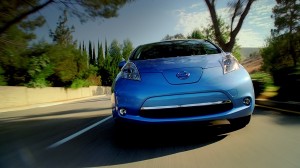 A lot of people are understandably wary about being early adopters of new technology. For the privilege, buyers often have to pay more and deal with unexpected problems. In the case of electric vehicles, the dynamic is the same, with many consumers worried about how long the batteries will last and what it will cost to replace them.
A lot of people are understandably wary about being early adopters of new technology. For the privilege, buyers often have to pay more and deal with unexpected problems. In the case of electric vehicles, the dynamic is the same, with many consumers worried about how long the batteries will last and what it will cost to replace them.
It’s hard to blame them. Reports from buyers of the first Nissan LEAF indicate that some batteries are failing pretty rapidly, sparking a class-action lawsuit. And some dealers of the Chevy Volt are quoting a whopping $34,000 for a full “drive motor battery replacement,” as Autoblog reports. Tesla, meanwhile, just unveiled a $29,000 replacement battery for their Roadster model, promising an additional 75 miles of range or so.
Autoblog performed a comprehensive look at what it might take to replace or repair a bad Chevy Volt battery, and the results are encouraging. For starters, after looking at the individual parts, the website found that while all three modules that make up the Volt battery add up to a fairly large $11,121.66 total, in most cases these battery cell modules do not need to be replaced:
There are many other individual pieces mounted on the battery pack that are serviceable, such as the Battery Energy Control Modules (BECM) and the Battery Interface Control Modules (BICM). These modules control and monitor the battery packs and charging system and have been known to fail while the lithium-ion battery cells are not at fault. Some have been replaced under warranty, but if you are stuck buying one they run about $255 a piece for the part. Getting a module replaced will cost you around $2,100 for parts, labor, and programming; labor can be a big hit since dropping the battery pack is required in order to service these modules.
If you are looking to replace the entire pack, the outlook has gotten better based on recent reports of refurbished battery packs becoming available for around $4,000. In these cases your entire battery pack is exchanged for one that comes from a refurbishing facility. These facilities do not produce any new parts but instead take packs that come in on exchange and combine the harvested pieces that are within spec from multiple packs to assemble refurbished packs.
Not bad prices if it buys you another 6-8 years of low-cost electric driving. The site includes a handy chart showing all the battery pack components:

Bottom line: fear of battery repair or replacement may not be such a big issue, particularly as we get more experience dealing with these used batteries coming out of the vehicles. Not to mention that there could and should be a robust market for buying these inexpensive used batteries, which would offer tremendous benefits for cleaning the grid and saving ratepayers money.
Electric vehicles as a clean technology movement have been in a holding pattern of late, if not a downright spiral. Sales are generally down from last year, battered by cheap gas prices and a lack of new models to excite consumers. Without advancements in the models, the broader consumer base is either unaware of EV benefits or cowed by perceived deficiencies (cost and range, mainly) of current EV options.
But that dynamic, I believe, is about to change.
New models are set to hit the roads this fall and winter that will likely start a new wave of EV buying. Most prominently, Tesla is finally talking to customers about designs for the new electric SUV, the Model X, set to release in limited production this month. The falcon-winged bad boy starts north of $130,000 though for the premium model, so sales will once again be aimed at the top 1% of us.
Chevy’s new Volt will also arrive this fall, complete with a marketing blitz. Early reviews sound positive, as the car looks better, drives longer on the battery (over 50 miles), and gets better gas mileage the few times you actually need it. Not to mention the new Nissan LEAF should be out soon, with possibly 120-mile range — a significant boost from the current 85-mile range.
When you add it up, the major EV automakers are set to introduce major upgrades to their products. While it’s harder to compete with cheap gas, EVs offer inherent benefits of a better and cleaner drive, lower maintenance costs, and the ability to drive for virtually free if you have solar PV on your roof. Plus, it’s the most important thing you can do for the environment if you have to drive.
So my guess is we’re in a holding pattern before some good news comes out on EV deployment. EVs won’t get to mass-market level for maybe another decade or so, but we’re getting there in big leaps, and this fall we should start to see another one take shape.
Well, it was bound to happen. After hearing other EV drivers tell me their horror stories, I finally (sort of) got one of my own.
On Wednesday last week, I parked my Nissan LEAF at an off-site airport parking lot for a four-day trip, returning Sunday evening. I was the sole adult with three children in tow and parked the car with about 70 percent of the battery remaining (more than enough to get back home). I loaded the luggage and kids onto the shuttle van, had a great trip, and returned to the car on Sunday evening. Everyone was ready to get home, have a quick, late dinner, and go to bed.
But lo and behold when I looked at the dashboard, the sign said “key not detected” and the battery was at only 20% capacity. The roughly 24 miles remaining was not enough for a 15-mile, mostly uphill trip home.
What happened? Evidently I had failed to turn the car off when I left it. And with no auto shut-off feature, the car battery slowly died over four days, presumably beeping for an undetected key that was in my pocket 400 miles away.
We weren’t going to make it home. Panic ensued. We had to find an available charger somewhere nearby as the battery quickly dwindled on the freeway. We finally located (via Plugshare.com) a ChargePoint Level 2 in a parking garage by an Amtrak station in Oakland’s Jack London Square. Thankfully one of the two parking spots/chargers was available when we pulled in.
Since I don’t have a ChargePoint membership, I had to call to activate the charger with my Visa. I was on hold for a few minutes, and after about 5 minutes I got it plugged in. Then I had to wait in an empty parking garage with three hungry and tired kids while the car slowly charged. I gave myself about 30 minutes, which I figured would be about an additional 10 miles or so — just enough to get home.
I unplugged after about 35 minutes to be safe and had 28% of the battery now. But it was still a white knuckle drive home as the dashboard said we had about 9 miles remaining when we were about 5 miles from home. It was not a pleasant way to end the trip.
Lessons learned? Of course I need to double-check that the car is actually turned off. But why did Nissan not include an auto shut-off feature? After a day left on with no key, I think it’s safe for the car to turn off automatically rather than draining the battery. I really hope Nissan fixes that problem. The car motor is silent and so it’s not always obvious that it’s been left on. And I’ve noticed that sometimes it’s easy to accidentally double-click the off button, which actually turns the car back on.
Still, all in all we were pretty lucky. We found a charger and everything worked out. With more charging stations deployed, this kind of situation will be easier to handle in the future. But it was an inconvenience that could have been avoided by Nissan, and not just by my being more careful. I surely will be in the future though.
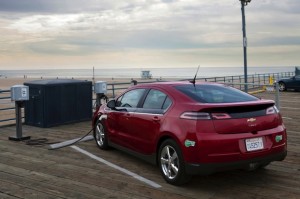 Among electric vehicle aficionados, the Chevy Volt is sort of a black sheep of the bunch. The car was one of the original “Big 3” of the electric vehicle market, along with the Nissan LEAF and Tesla Model S. But unlike those two cars, which represented opposite ends of the price and range spectrum for an all-battery vehicle, the Chevy Volt tried to be an all-in-one consumer car. For about $34,000 (without incentives), it features a 38-mile all-electric battery range. And then a gas engine kicks in to give you the full range of an internal combustion engine car.
Among electric vehicle aficionados, the Chevy Volt is sort of a black sheep of the bunch. The car was one of the original “Big 3” of the electric vehicle market, along with the Nissan LEAF and Tesla Model S. But unlike those two cars, which represented opposite ends of the price and range spectrum for an all-battery vehicle, the Chevy Volt tried to be an all-in-one consumer car. For about $34,000 (without incentives), it features a 38-mile all-electric battery range. And then a gas engine kicks in to give you the full range of an internal combustion engine car.
But the Volt has some obvious limitations. First is the 38-mile battery range. After that, the gas engine requires more expensive premium gas. And some customers complained about the lack of room in the back seat, with two adults fitting uncomfortably (whereas I can fit two carseats and a booster in the backseat of my LEAF). Perhaps as a result, sales have fallen in the last two years, as Inside EVs reports:
For full year 2014, 18,805cars were been sold – which is down 18.6% from 2013 when GM moved 20,702 Volts. This means that the Volt is the first electric vehicle to post two consecutive years of falling sales in America.
Some analysts believe the drop-off was in part due to customer awareness that Chevy was about to introduce a new version of the Volt this year. And that just happened:
The big news — other than the sleeker, all-new design — is that electric-only range has increased about a dozen miles to 50. At that point, a gas engine kicks in, offering a total range of “more than” 400 miles before a fill-up and recharge are necessary. The engine is all-new, a 1.5-liter unit that takes regular gas and delivers a combined fuel economy of 41 mpg when in use. Charging comes in 4.5 hours connected to a 240-volt source.
Yet if I had to guess, I think the Volt’s electric/gas combo presents a fundamental consumer challenge that will be hard to overcome. And it’s a problem for virtually any plug-in electric that also has a gas engine. In my view, with the electric/gas combo, you get the worst of both worlds without inspiring passion among any consumer group. The battery range isn’t enough to get drivers gas-free, a major shortcoming if you’re motivated by either environmental concerns or a desire for the superior driving experience of going electric. And the gas part of the car is expensive (premium fuel) and negates the low-maintenance advantage of an all-electric: you still need the extra thousand moving parts for an internal combustion engine, with all the sparkplugs and oil changes and transmissions to worry about.
I think most drivers want either all-electric or nothing. The extra range with a gas engine isn’t that necessary for most trips. An 85-mile range in a cheap all-battery car covers 95% of trips. You’re almost better off renting a cheap car for those few long-distance trips a year, rather than sticking a gas engine in your battery EV. The Volt is certainly a good car for those who only want one all-purpose car and really need the extra range from the gas engine — basically long-distance commuters. But I don’t think this plug-in/gas model is really viable in the long run, particularly as batteries improve in price and performance.
Perhaps that’s why Chevy is now working on the “Bolt” — an all-electric, $30,000, 200 mile range EV to compete with Tesla’s hyped up Model 3, due supposedly in 2017. It’s great to see the automakers competing for this coveted breakthrough in EV technology. And once the Bolt is out, I will definitely consider a Chevy EV. But not so much with the Volt.
Nissan LEAF is currently number one in electric vehicle sales, the result of CEO Carlos Ghosn’s vision to build a low-cost EV to create a mass market. Ghosn sat down recently with Charlie Rose to discuss the current state of EVs, worth watching in full:
On a related note, with the LEAF now finally entering the realm of profitability on the heels of 200,000 units sold worldwide, Nissan is launching a major new ad campaign. Charged EV magazine has the details. Here’s a sample ad from the “Kick Gas” campaign:

